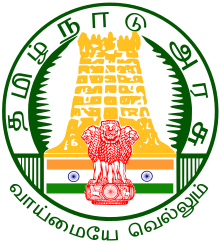The Department of Handlooms, Handicrafts, Textiles and Khadi is one of the departments of Government of Tamil Nadu.
 | |
| Agency overview | |
|---|---|
| Formed | 1956 |
| Jurisdiction | Tamil Nadu |
| Headquarters | Chennai |
| Minister responsible |
|
| Agency executive |
|
| Parent agency | Government of Tamil Nadu |
| Website | Handlooms, Handicrafts, Textiles and Khadi Department |
Objective
editThe objective of the department is to promote the growth of various components of the textile industry such as handloom, powerloom, spinning and finished garments.[1]
Textile industry
editThe state is home to more than half of the operating fiber textile mills in India.[2][3] Coimbatore is often referred to as the Manchester of South India due to its cotton production and textile industries.[4][5] As of 2022[update], Tiruppur exported garments worth $480 billion, contributing to nearly 54% of the all the textile exports from India and the city is known as the knitwear capital due to its cotton knitwear export.[6][7] As of 2015[update], the textile industry in the state accounted for 17% of the total invested capital in all the industries.[8] As of 2021[update], 40% of leather goods exported from India worht ₹9,252 crore (US$1.1 billion) are being manufactured in the state.[9]
Kanchipuram silk sari is a type of silk sari made in the Kanchipuram region the state which has been recognized as a Geographical indication by the Government of India in 2005–2006.[10][11] Kovai Cora Cotton and Bhavani Jamakkalam are other noted Geographical indications.[11][12]
Departments and functions
editHandlooms and textiles
edit- Textiles
The state is one of the largest producer of textile yarns and finished garments, accounting for more than 70% of the national output. The department is responsible for the management of entire textile supply chain including facilitating resources including materials, land and labour, textile machinery, education and research and promotion.[13] The department also provides for various savings and pension schemes to support the industries. The government also procures free school uniforms and textiles for distribution to the poor from the textile co-operative industries.[13]
- Handloom
The handloom industry employs more than 2.4 lakh workers with more than 52% women in 1.55 lakh units. The state has the third highest number of handlooms and the highest number of handloom weavers in co-operative units. The department of handlooms is responsible for ensuring the sustainability of the weavers by facilitating raw materials for production, infrastructure support, marketing and sales of finished goods through Co-optex.[13]
- Powerloom
The powerloom sector in the state accounts for one fifth share of the country with 5.63 lakh units and employing more than ten lakh people. The department is responsible for modernization of the powerloom sector, up-skilling of workers and facilitating marketing and exports.[13]
- Sericulture
The state is the third largest producer of silk and the sericulture department is responsible for increasing the silk output, modernization of the industry, education of farmers, research and marketing.[14]
Handicrafts and Khadi
edit- Handicraft
The handicraft board is responsible for training of artisans, facilitate employment and benefits, improve productivity and quality and sales and marketing of products through "Poompuhar".[14]
- Khadi
The Khadi board was created in 1960 and is responsible for improving the production of khadi products, facilitation of financing and social benefits to khadi producers in rural areas and marketing of the products.[14]
- Palm products
The Palm products development board functions under the department and was established in 1994. It is responsible for safeguarding the interests of palm farmers, improve production, facilitation of sales and marketing of products.[14]
See also
editReferences
edit- ^ "Handlooms, Handicrafts, Textiles and Khadi department". Government of Tamil Nadu. Retrieved 1 December 2023.
- ^ "State wise number of Textile Mills" (Press release). Press Information Bureau, Government of India. 7 August 2014. Retrieved 23 January 2023.
- ^ "Lok Sabha Elections 2014: Erode has potential to become a textile heaven says Narendra Modi". DNA India. 17 April 2014. Retrieved 20 March 2016.
- ^ "SME sector: Opportunities, challenges in Coimbatore". CNBC-TV18. 24 February 2011. Archived from the original on 11 March 2011. Retrieved 9 May 2011.
- ^ "Nicknames of places in India". Archived from the original on 3 May 2015. Retrieved 28 June 2015.
- ^ "How can India replicate the success of Tiruppur in 75 other places?". Business Standard. Retrieved 1 November 2023.
- ^ "Brief Industrial Profile of Tiruppur district" (PDF). DCMSME. Ministry of Micro, Small & Medium Industries, Government of India. Archived (PDF) from the original on 4 March 2016. Retrieved 3 May 2015.
- ^ Sangeetha Kandavel (24 July 2015). "New textile policy on the anvil". The Hindu. Archived from the original on 4 September 2015. Retrieved 25 July 2015.
- ^ "TN to account for 60% of India's leather exports in two year". The Times of India. 6 September 2022. Retrieved 1 December 2023.
- ^ "Weaving through the threads". The Hindu. Retrieved 7 March 2015.
- ^ a b Geographical indications of India (PDF) (Report). Government of India. Retrieved 28 June 2023.
- ^ "31 ethnic Indian products given". Financial Express. Retrieved 28 June 2015.
- ^ a b c d "Handlooms and Textiles department, policy note 2023-24" (PDF). Government of Tamil Nadu. Retrieved 1 December 2023.
- ^ a b c d "Sericulture, handicrafts and Khadi department, policy note 2023-24" (PDF). Government of Tamil Nadu. Retrieved 1 December 2023.